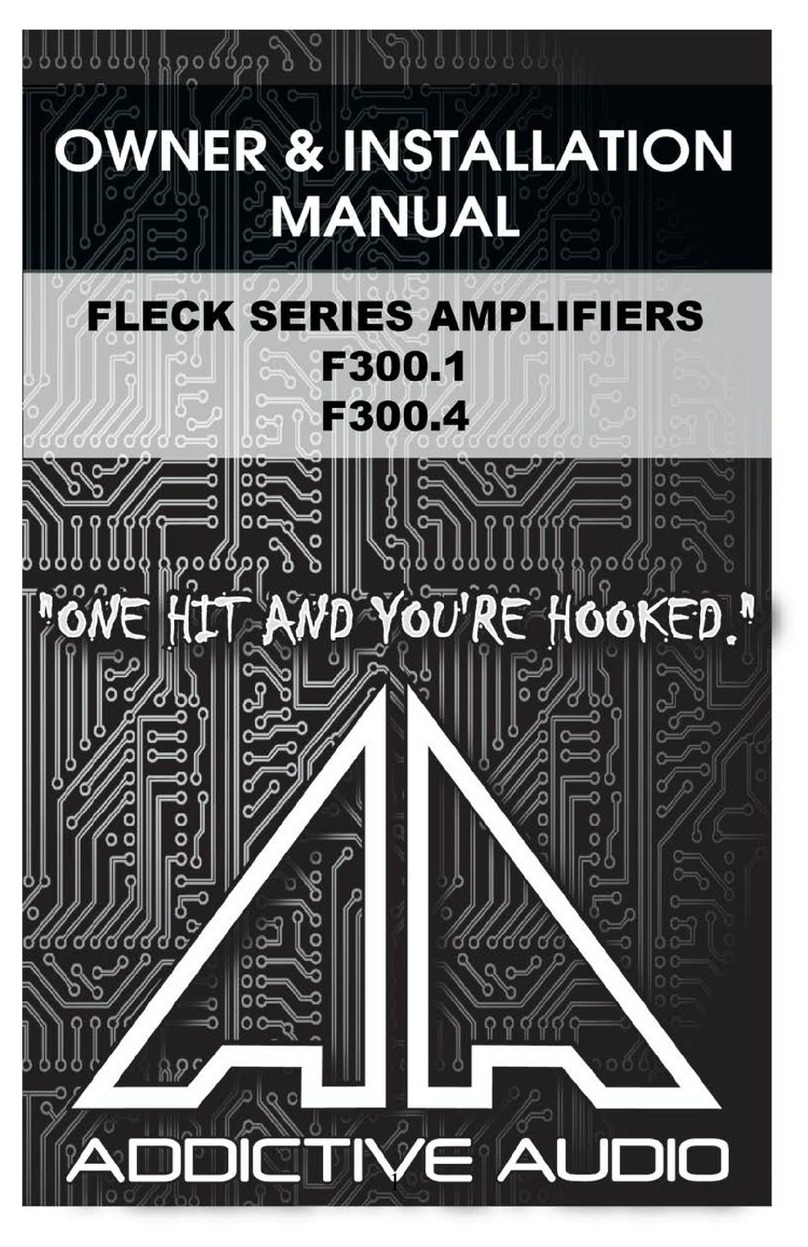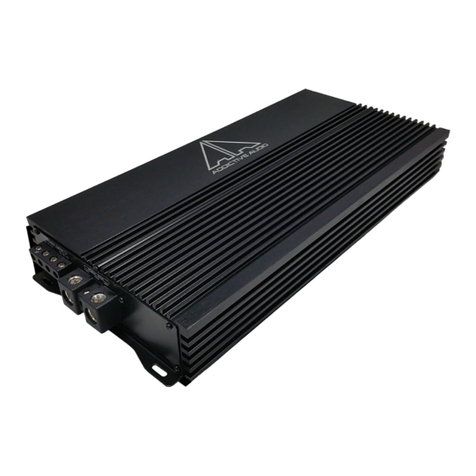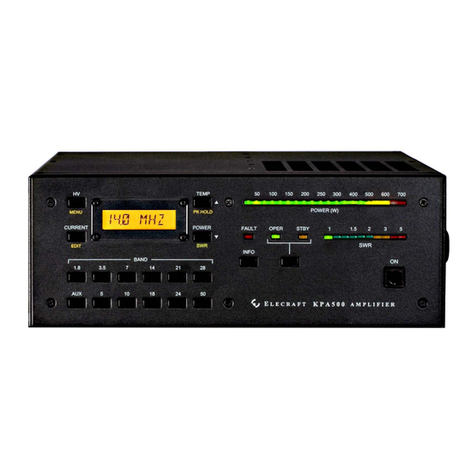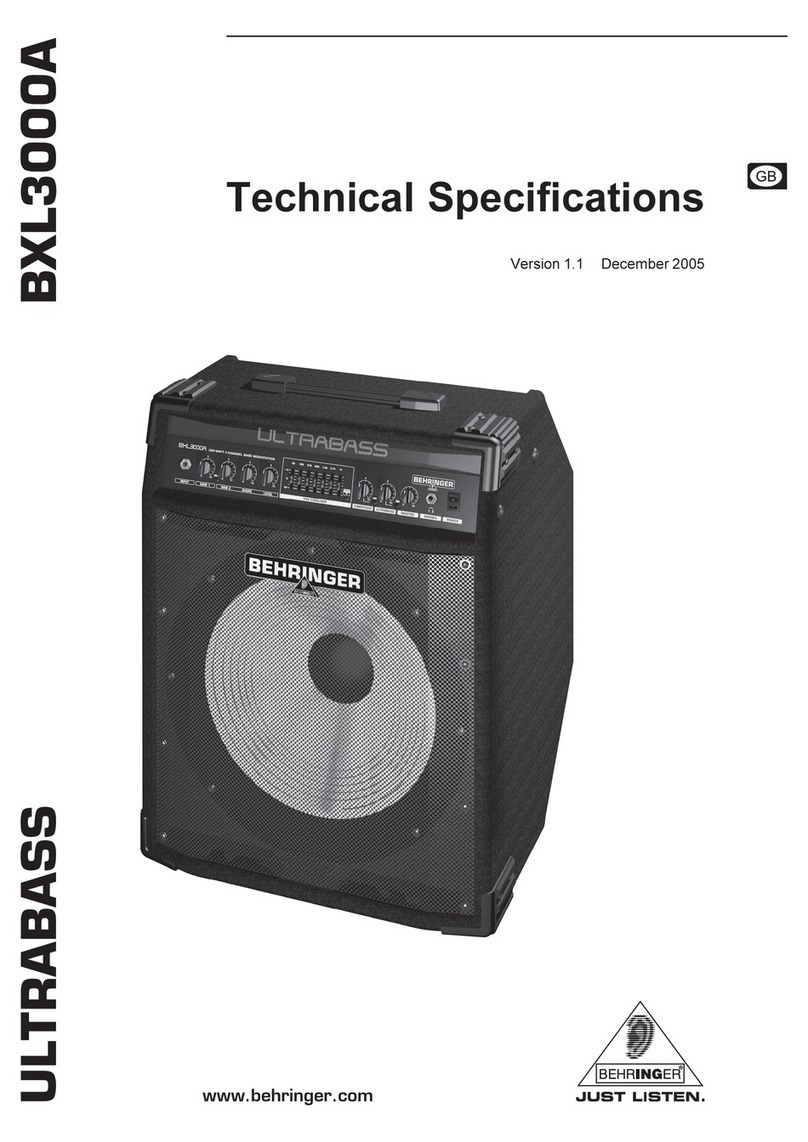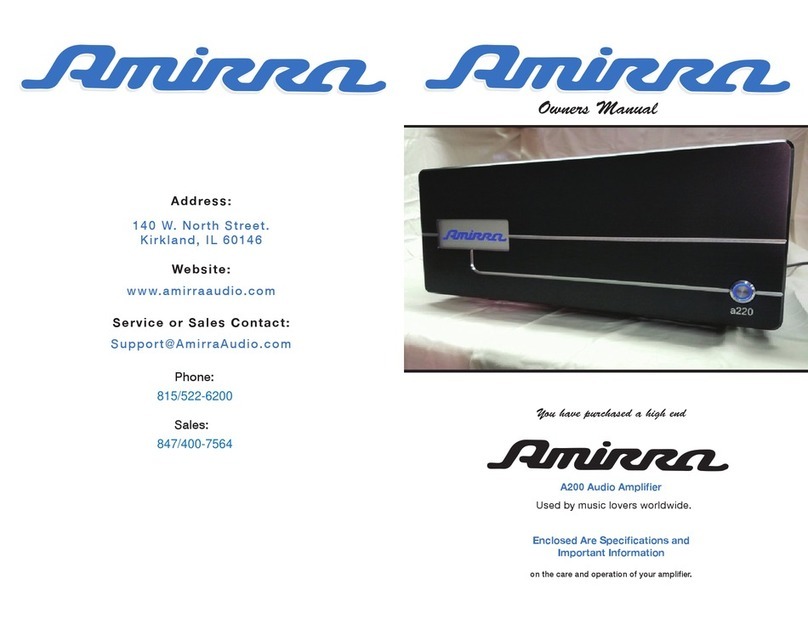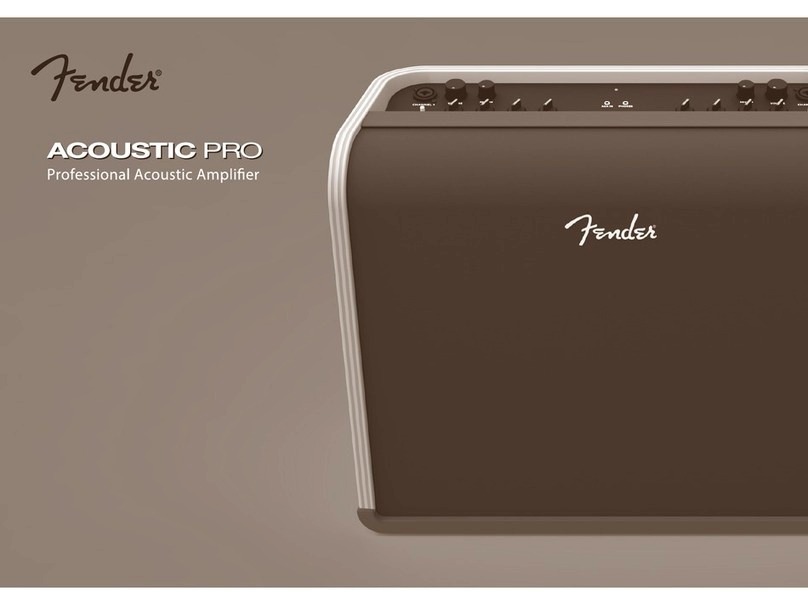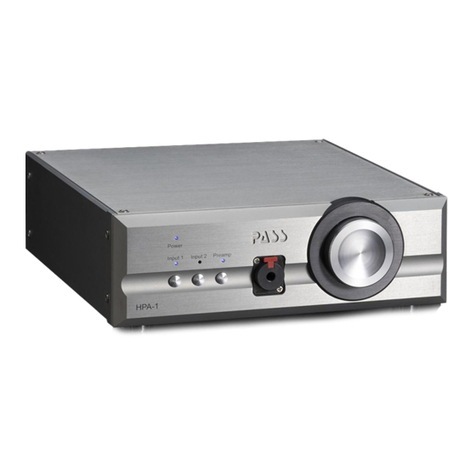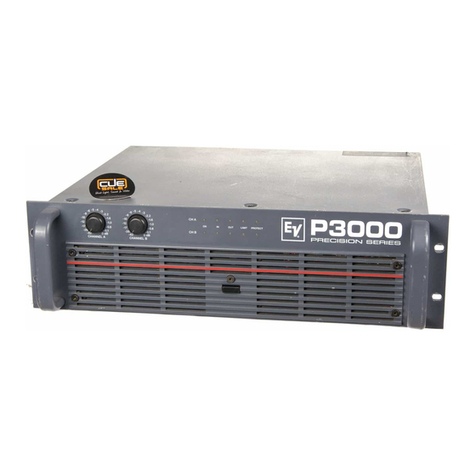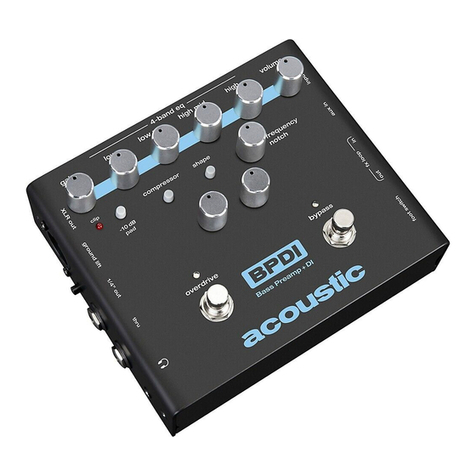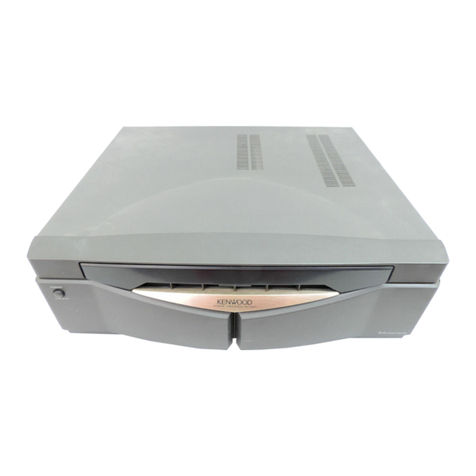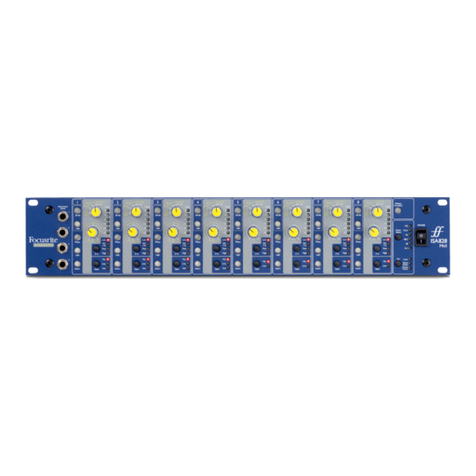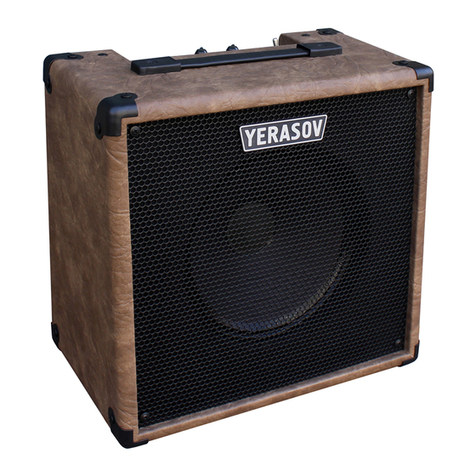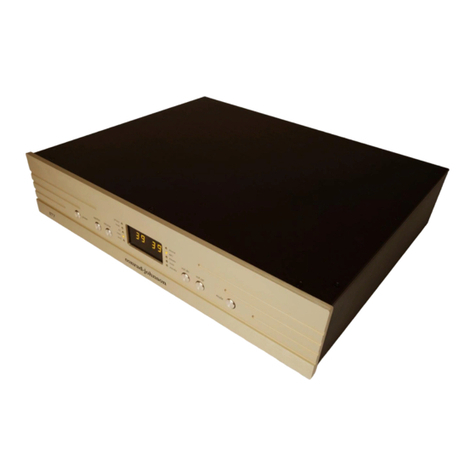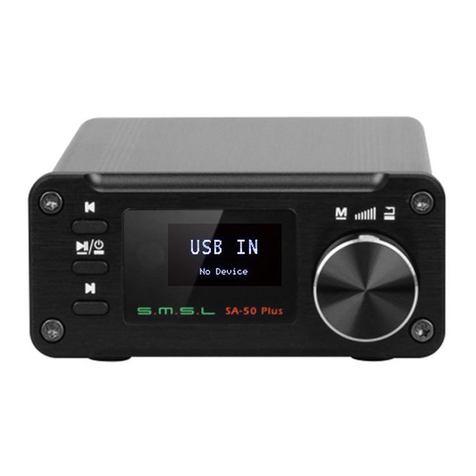Addictive audio 50.1D User manual

1

2
Specifications
50.1D (13.8V) SINGLE STRAPPED
Signal to Noise Ratio >95dB
90% Efficiency THD: <0.5%
Lowest Recommended Load 1ohm
240 watts RMS @ 4ohm Mono
435 watts RMS @ 2ohm Mono
695 watts RMS @ 1ohm Mono
860 watts RMS @ 4ohm Mono
1340 watts RMS @ 2ohm Mono
Not stable to 1ohm strapped
100.1D (13.8V) SINGLE STRAPPED
Signal to Noise Ratio >95dB
90% Efficiency THD: <0.5%
Lowest Recommended Load 1ohm
480 watts RMS @ 4ohm Mono
840 watts RMS @ 2ohm Mono
1260 watts RMS @ 1ohm Mono
1660 watts RMS @ 4ohm Mono
2440 watts RMS @ 2ohm Mono
Not stable at 1ohm strapped
200.1D (13.8V) SINGLE STRAPPED
Signal to Noise Ratio >95dB
90% Efficiency THD: <0.5%
Lowest Recommended Load 1ohm
800 watts RMS @ 4ohm Mono
1385 watts RMS @ 2ohm Mono
2190 watts RMS @ 1ohm Mono
2640 watts RMS @ 4ohm Mono
4320 watts RMS @ 2ohm Mono
Not stable to 1ohm strapped
_______________________________________________________
Common Design Features
9EASY CLICK Selectable Center Point Frequency (20-85Hz)
Bass Boost up to +12dB (refer to pg. 13 for adjusting this
feature)
9Clipping Circuit with LED Indicator
9Short Circuit, Thermal, Low / High / Reverse Voltage
Protection
9EASY CLICK on all Frequency Adjustments for Simple and
Exact Tuning
9Heavy Duty Aluminum Heatsink for Max. Heat Dissipation
9Input Sensitivity: 220mV – 6.6Vrms
9Class D High Efficiency (90%) Design
9Selectable Status Light ( White or Blue or Off )
9EASY CLICK Low Pass Filter: 50 – 250Hz (24dB/Octave)
9EASY CLICK Subsonic Filter: 10 – 55Hz (24dB/Octave)
9Frequency Response -3dB 15Hz – 238Hz
9All Models STRAPPABLE with the provided Data Link Cable
(Refer to Fig. 6)
9Laser Etched Logo (Not another Peel-n-Stick amp)
9Remote Gain Control Included
9Designed & Engineered in the U.S.A.

3
CONGRATULATIONS!
Selecting fine audio equipment, such as the Addictive Audio unit you have just
purchased, is only the beginning of your musical enjoyment. Now is the time to
consider how to maximize the fun and excitement your equipment has to offer.
Addictive Audio and the Electronic Industry Associations Consumer Electronic
Group want you to get the most out of your equipment by playing it at a safe level,
a level that lets the sound come through loud and clear without annoying blaring
distortion; most importantly, without affecting your sensitive hearing.
Sound can be deceiving over time your hearing “comfort level” adapts to higher
volumes of sound, what may have sounded “normal” can actually be too loud and
harmful to your hearing.
Prevent this by setting your equipment at a safe level BEFORE your hearing
adapts.
To establish the “safe level”.
• Start your volume control at a low setting.
• Slowly increase the sound until you can hear it comfortably and clearly, and
without distortion.
• Once you have established a comfortable “sound level” make a note of this
position and do not go above this setting.
Taking a minute to do this will help to prevent hearing damage in the future.
After all, we want you listening for a lifetime.
Introduction
Your ADDICTIVE AUDIO amplifier has been designed to give you very high
performance, and valuable features, at a very reasonable price. Take the time to
read over this brief set of instructions, and you will get full enjoyment from your
system.
Installation
The quality of the installation will affect system performance and reliability. You
may wish to contact a dealer or professional installer. The amplifier is generally
mounted in the rear trunk area but can be mounted in any convenient area such as
beneath a seat. Please be sure to locate this unit where you have reasonable air
circulation and protection from any moisture.
When considering the mounting location you should minimize the length of the
power supply and speaker leads. Minimizing both leads will provide higher audio
output from the system. It is important to ensure that the heat sink is not against a
panel or a surface preventing air circulation. Mark the location for the mounting
screw holes by using the amplifier as a template. Drill #29 or 9/64” diameter holes

at the marked locations and firmly fasten the amplifier in place with the mounting
screws supplied in the accessory kit.
Caution
Before drilling or cutting any holes investigate the layout of your automobile
thoroughly! Take care when working near the gas lines, hydraulic lines and
electrical wiring.
WARNING
This power amplifier has a protection feature to prevent any damage from misuse
or faulty conditions - excessive heat, short circuit speakers or overload. If the unit
senses one of the above conditions, the protection indicator will light and the
system will shut down. To diagnose the problem turn all levels down, all power off
and check the installation for possible wiring mistakes or shorts. In the event the
amplifier shuts down due to excessive heat under adverse conditions simply allow
time for the unit to cool down at which time, the protection indicator will not light.
Power Supply Connections
The +12VDC and GROUND wires should be heavy gauge copper wire with heavy
insulation and of the same gauge. Please see the chart below for recommended
gauge and fuse.
50.1 60 AMP FUSE 4 GAUGE
100.1 90 AMP FUSE 4-2 GUAGE
200.1 150 AMP FUSE* 0 GUAGE
* One 150 amp ANL fuse and holder is supplied with every 200.1 amplifier. This fuse is to be used
within 8” of amplifier. It is recommended to place another 150 amp ANL fuse within 16” of the main
battery.
In addition, it has a 12V remote control wire and it should be 14AWG-18AWG.
It is preferable to have longer speaker wires and shorter power supply wires to
minimize power losses.
4

+12V Power (+12V)
This wire is usually connected directly to the positive battery terminal. Be sure to
use proper fuse as rated above within 16 inches of the main battery. (Refer to Fig. 1a
and 1b)
Ground (GND) Same gauge as +12V and no longer than 36”
This connection must be completed using an “O” ring (to prevent coming loose)
with insulating sleeve. This wire is the electrical ground and must be fastened
securely to the vehicle chassis. The best method is to use threading sheet metal
screw(s) since the threads cut into bare metal. Ensure that all paint coating or
other insulation is removed from around the ground area. Use as short of a piece
of cable as possible – Again, use the same gauge as the +12V. (Refer to Fig. 1a and 1b)
Remote (REM)
Many source units (cd player) or other music sources have an output terminal for
connection of the remote turn-on of the power amplifier. If the source unit doesn’t
have a remote turn-on feature, then you can connect the remote wire to a switch
that derives power from an ignition switched circuit. (Refer to Fig. 1a and 1b)
Power Input Connections
Caution
First make +12V wire connection then the ground connection and finally the
remote connection. Furthermore the +12V wire must always be fused at the
battery for protection against possible damage. If you need to replace the power
fuse, replace it with a fuse of the same value. Using a fuse of a different type or
rating may result in a serious hazard.
5

Signal Input (RCA)
Addictive Audio amplifiers have RCA connection type input terminal for low
level input. A standard pair of RCA type cables can be used for all models (Refer to
Fig. 2). The amplifiers allow both stereo and mono input. The amplifier internally
will take a stereo signal and convert to a mono signal. If using the low level output
of one amplifier to provide signal to a stereo amplifier, you must input stereo signal
to the amplifier providing signal to secondary amplifier. If mono input to initial
amplifier is made the output to stereo (secondary) amplifier will also be mono.
Adjustment of input level is accomplished by the gain control. Adjusting this
control allows the amplifier gain to be controlled to match the source unit.
Signal Input Connections
6

7
ns
Speaker Output Connectio

Strapping/Linking 2 Amplifiers to 1 Subwoofer (Fig. 6)
Caution
Input voltage under unloaded condition should be less than 16Volts.
Impedance of two amplifiers STRAPPED is 4 ohm and 2 ohm (2ohm being the minimum).
8

Features and Controls 50.1 / 100.1 / 200.1 (Fig.7)
1. RCA Line Output Jacks
Allows signal to pass through to another amplifier.
2. RCA Line Input Jacks
Input signal from source unit through RCA cable.
Input Gain Level Control *NOT A VOLUME KNOB*
o match the
ent from 0.2V
to 6.0V.
3.
This allows for the adjustment of the gain of both channels t
output level of the source unit. In addition, it allows adjustm
9

10
4. 0-180 Degree Phase Alignment
Allows for the time correction of music signals to prevent phasing
cancellation or music blurring.
5. Subsonic Filter with EASY CLICK (Refer to Pg. 13 for Adjusting)
Control the high pass crossover point for the speaker outputs to eliminate
ultra low frequencies. This crossover is always on with a 24dB per octave
slope and adjustable from 10-55Hz. This filter is used mainly in ported
applications, to protect the speakers from excessive excursion below the
port tuned frequency. Not necessary when dealing with sealed
enclosures, but can still be used to help protect the speaker system.
Low Pass Filter with EASY CLICK (Refer to Pg. 13 for Adjusting)
crossover point for the speaker outputs. This
octave and adjustable
upper frequencies from
subwoofer.
. Cen sting)
sition. This
ed
pplications. A majority of companies only offer a bass boost that
only allows the ability to boost a certain amount of dB at 45Hz. To adjust
the Addictive Audio amplifier according to this “industry average” set the
Center Frequency to 45Hz (16 clicks).However, we don’t recommend this
because Addictive Audio is NOT industry average.
8. Boost
This allows the ability to BOOST the Center Frequency (#7 on Fig. 7) up to
+12dB. The “Bass EQ” above (#9 on Fig. 7 ) must me in the ON position.
st can be adjusted. When turned off the all
6.
This controls the lowpass
crossover is always on with a slope of 24dB per
from 50-250Hz. This filter reduces unwanted
being played through the
ter Frequency with EASY CLICK (Refer to Pg. 13 for Adju7
The “Bass EQ” Above (#9 on Fig. 7) must me in the ON po
allows adjustment of the center frequency (20-85Hz) that will be boost
via the BOOST adjustment above (#8 on Fig. 7). This allows the ability to
help “Boost” frequency ranges that are lacking in a sound system or help
with SPL a
9. Bass EQ On / Off
This turns the BASS EQ (#7 & #8 above Fig. 7) on or off. When turned on
the Center Frequency and Boo
Bass EQ adjustments are disabled.
10. Remote Gain Control
This allows an external bass knob (included) to adjust the subwoofer from
a more convenient location in the vehicle or in the event the stock head
unit is being used. Most aftermarket mid to high-end head units already
offer subwoofer adjustment. However, the bass knob can still be used,
but is not necessary.
11. STRAP Data Link

11
ly stable to 2ohm mono.
occurs:
Reverse Voltage (Immediately)
ately illuminate yellow when clipping is detected. The brighter and
This allows the supplied 6P phone cable (Data Link) to pass signal
through to the Slave amplifier. This must be used when strapping
two amplifiers.
CAUTION: Strapped amplifiers are on
12. Master / Slave Selection
When strapping two amplifiers together the Master amplifier must be set
to MAS and Slave amplifier must be set to SLV via this switch.
13. Power / Protection / Clipping Indicator LED
POWER LED: Will illuminate GREEN when +12VDC is applied to both the remote turn on
and +12V input from the battery and a solid ground has been made. The input
from the battery to the amplifier can be more than 12VDC.
PROTECTION: Will illuminate RED when any one of the following
Short Circuit (Immediately)
Thermal (On at 141*F or 60*C)
Low Voltage (On at 9VDC)
High Voltage (On at 18VDC)
CLIPPING: Will immedi
more solid the LED is lit = the more potential damage to the speakers.
C may be heard as general distortion or as pops. The untrained ear often over lookslipping
this. Because the clipped waveform has more area underneath it than the smaller unclipped
waveform, the amplifier produces more power when it is clipping. This extra power can
d any part of the loudspeaker, including the woofer or the tweeter, by causing over-amage
ex n, or by overheating the voice coil. Addictive Audio uses the CLIPPING LED tocursio
he E” when clipping occurs, without this, our only other option would be to givelp “SE
ev an oscilloscope.eryone
r
1.
nection does not occur during the installation process.
2. t attach the
battery until all wires have been plugged into
nter clockwise).
Hz (7 clicks), set the
rt
Adjusting the Amplifie
Disconnect the negative battery post and secure it to something so
accidental re-con
Run all wires needed for the amplifier to work correctly. Do no
fuse in the fuse holder by the
the amplifier.
3. Turn the amplifiers gain and boost all the way down (cou
4. As a good “starting point” set low pass filter to 80
subsonic to the tuning frequency of your enclosure (refer to EASY CLICK cha
r exact tuning), and set the phase to 0.
on pg.13 fo

12
and the Strap Mode switch is set
MAS
in Control (Bass knob) turn the dial all the
7. Attach the recommended fuse (refer to fuse chart on pg.4) to the fuse holder by
10. Set the head unit’s tone controls, balance, and fader to the center or flat
n off any loudness or other signal processors.
ad
e speakers reach the maximum undistorted output. Keep an
and adjust the BOOST
ve i it effectively and
or overall system
5. Make sure Bass EQ switch is set to OFF
to .
6. If using the supplied Remote Ga
way up to the max. (full clockwise)
the main battery.
8. Re-attach the negative battery post from step 1.
9. Turn the head unit on and start at a low volume. Check amplifier to make
sure all wires are correct and no protection lights are on.
position. Be sure to tur
11. Use a very clear original recording not mp3 or burned cd. Turn the volume
of the head unit to its maximum undistorted volume. On most quality he
units this is around 7/8 of the maximum volume.
12. Slowly turn up the gain (clockwise) to match the voltage output of the head
unit or until th
eye on the clipping LED!
13. Re-adjust the low pass filter and phase if needed.
14. Turn the Bass EQ “ON” if desired. Now set the center point frequency
(refer to EASY CLICK chart on pg. 13 for exact tuning)
nstalled the Bass Knob, now you can use
fmusic to check f
accordingly. Keep an eye on the clipping LED!
15. If you ha
safely.
16. Play a few different selections o
balance.
17. ENJOY!

13
EASY CLICK ADJUSTMENT CHART

14

15
NOTES
Many vehicles have small and insufficient wire to connect the alternator’s positive
connection to the battery and to ground the battery to the vehicle chassis. To prevent
voltage drops, these wires should be upgraded to 4-0 AWG when installing one or more
Addictive Audio amplifiers.
___________________________________________________
___________________________________________________
___________________________________________________
___________________________________________________
___________________________________________________
___________________________________________________
___________________________________________________
___________________________________________________
___________________________________________________
___________________________________________________
___________________________________________________
___________________________________________________
___________________________________________________
___________________________________________________
___________________________________________________
___________________________________________________
____________________________________________________
___ _
__
_
__________________ ________________
_
_
_
_
_
_
_
_
_
_
_
_
_
_
_
_
________________________________________________
__________________________________________________
___________________________________________________
__________________
____________________________________________________
____________________________________________________
____________________________________________________

16

17

18
Specifications
25.1AB (13.8V) STEREO BRIDGED
Signal to Noise Ratio >95dB
High Efficiency 81% THD: 0.1%
Lowest Recommended Load:
2ohm Mono
N/A
205x1 watts RMS @ 4ohm
300x1 watts RMS @ 2ohm Do
Not Operate at 1ohm Mono
20.2AB (13.8V) STEREO BRIDGED
Signal to Noise Ratio 101dB
High Efficiency 78% THD: 0.1%
Lowest Recommended Load:
2ohm Stereo or 4ohm Mono
230x2 watts RMS @ 4ohm
350x2 watts RMS @ 2ohm
Do Not Operate at 1ohm Stereo
660x1 watts RMS @ 4ohm
Do Not Operate at 2ohm or
1ohm Bridged
5.4AB (13.8V) STEREO BRIDGED
Signal to Noise Ratio 104dB
High Efficiency 81% THD: 0.05%
Lowest Recommended Load:
2ohm Stereo or 4ohm Mono
65x4 watts RMS @ 4ohm
95x4 watts RMS @ 2ohm
Do Not Operate at 1ohm Stereo
170x2 watts RMS @ 4ohm
Do Not Operate at 2ohm or
1ohm Bridged
10.4AB (13.8V) STEREO BRIDGED
Signal to Noise Ratio 104dB
High Efficiency 81% THD: 0.05%
Lowest Recommended Load:
2ohm Stereo or 4ohm Mono
115x4 watts RMS @ 4ohm
170x4 watts RMS @ 2ohm
Do Not Operate at 1ohm Stereo
330x2 watts RMS @ 4ohm
Do Not Operate at 2ohm or
1ohm Bridged
_______________________________________________________
Common Design Features
9Bass Boost from 0 to +18dB (45Hz)
9Clipping Circuit with LED Indicator
9Short Circuit, Thermal, Low / High / Reverse Voltage Protection
9EASY CLICK on all Frequency Adjustments for Simple and Exact Tuning
(LPF, HPF and Subsonic)
9Heavy Duty Aluminum Heatsink for Max. Heat Dissipation
9Input Sensitivity: 220mV – 6.6Vrms
9Class AB Design
9Selectable Status Light (White or Blue)
9EASY CLICK Low Pass Filter: 50 – 150Hz (-12dB/Octave)
9EASY CLICK High Pass Filter: 50 – 500Hz (-12dB/Octave)
9EASY CLICK Subsonic Filter: 25 – 40Hz (-12dB/Octave)
9Laser Etched Logo (Not another Peel-n-Stick amp)
9Heavy Duty Copper Trace PCB Board
9Direct Cable Connection for Superior Conductivity
9Designed & Engineered in the U.S.A.

19
s!
just
g
ize the fun and excitement your equipment has to offer.
dustr nic
afe level,
d clea ing
,ensitive hea
gher
nd
tting e your hearing
”
ntrol at a low setting.
omfortable “sound level” make a note of this
t
k hearing damage in the future.
Introduction
Your ADDICTIVE AUDIO amplifier has been designed to give you very high
performance, a very reasonable price. Take the time to
ment from your
em.
Installation
he taller. The amplifier is generally
ient area such as
beneath a seat. Please be sure to locate this unit where you have reasonable air
e the length of the
l provide higher audio
output from t sink is not against a
rk the location for the mounting
eter holes
e mounting
Congratulation
qu ch as the AddictivSelecting fine audio e ipment, su e Audio unit you have
purchased, is only the be inning of your musical enjoyment. Now is the time to
consider how to maxim
Addictive Audio and the Electronic In y Associat
Group want you to get the most out of your equipment by playing it at a s
ions Consumer Electro
a level that lets the soun come through loud and r without annoying blar
distortion; most importantly without affecting your s ring.
Sound can be deceiving over time your hearing “comfort level” adapts to hi
volumes of sound, what may have sounded “normal” can actually be too loud a
harmful to your hearing.
Prevent this by se your equipment at a safe l vel BEFORE
adapts.
To establish the “safe level .
• Start your volume co
• Slowly increase the sound until you can hear it comfortably and clearly, and
without distortion.
• Once you have established a c
posi ion and do not go above this setting.
Ta ing a minute to do this will help to prevent
After all, we want you listening for a lifetime.
and valuable features, at
read over this brief set of instructions, and you will get full enjoy
syst
T quality of the installation will affect system performance and reliability. You
may wish to contact a dealer or professional ins
mounted in the rear trunk area but can be mounted in any conven
circulation and protection from any moisture.
When considering the mounting location you should minimiz
power supply and speaker leads. Minimizing both leads wil
he system. It is important to ensure that the heat
panel or a surface preventing air circulation. Ma
screw holes by using the amplifier as a template. Drill #29 or 9/64” diam
at the marked locations and firmly fasten the amplifier in place with th
screws supplied in the accessory kit.

Caution
Before drilling or cutting any holes investigate the layout of your automobile
thoroughly! Take care when working near the gas lines, hydraulic lines and
electrical wiring.
WARNING
This power amplifier has a protection feature to prevent any damage from misuse
or faulty conditions - excessive heat, short circuit speakers or overload. If the unit
senses one of the above conditions, the protection indicator will light and the
system will shut down. To diagnose the problem turn all levels down, all power off
and check the installation for possible wiring mistakes or shorts. In the event the
amplifier shuts down due to excessive heat under adverse conditions simply allow
time for the unit to cool down at which time, the protection indicator will not light.
Power Supply Connections
40 AMP FUSE 8 GAUGE
The +12VDC and GROUND wires should be heavy gauge copper wire with heavy
insulation and of the same gauge. Please see the chart below for recommended
gauge and fuse.
25.1
20.2 80 AMP FUSE 4 GAUGE
5.4 60 AMP FUSE 8 GAUGE
10.4 80 AMP FUSE 4 GUAGE
In addition, it has a 12V remote control wire and it should be 14AWG-18AWG.
es of the main battery.
It is preferable to have longer speaker wires and shorter power supply wires to
minimize power losses.
+12V Power (+12V)
This wire is usually connected directly to the positive battery terminal. Be sure to
proper fuse as rated above within 16 inchuse
(Refer to Fig. 1)
Ground (GND) Same gauge as +12V and no longer than 36”
This connection must be completed using an “O” ring (to prevent coming loose)
with insulating sleeve. This wire is the electrical ground and must be fastened
20
This manual suits for next models
2
Table of contents
Other Addictive audio Amplifier manuals

